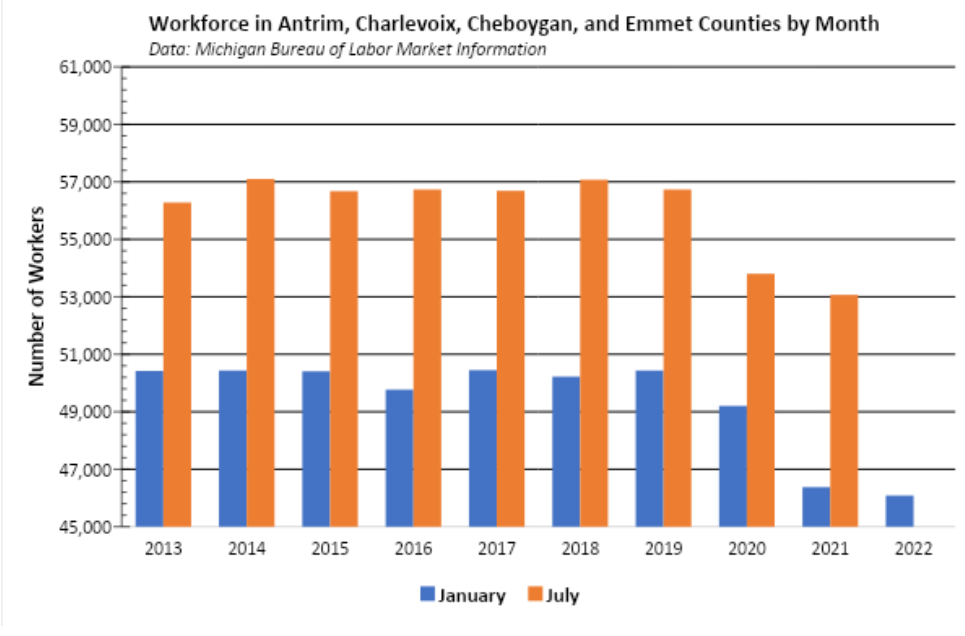This article examines the integral role of young workers in meeting seasonal labor demands. However, long term demographic trends show this labor pool is shrinking.
By: Sam Bailey, NLEA Strategic Initiatives Manager
With high school and college students now on summer break, many local businesses are hoping to gain some relief from the national labor shortage. Governor Whitmer is highlighting the importance and potential of teenage workers by proclaiming June 2022 as Youth Employment Month. Many local businesses—restaurants, bars, marinas, golf course, retailers, and others—rely on these workers to meet the huge demands of summer tourism. However, a seventeen-year decline in local school enrollments and sixteen-year decline in the seasonal labor force mean that businesses will not receive as much relief as they hoped.
While businesses are excited for teenage workers to return for the summer months, the business community is not receiving the same bump that it used to. Between 2002 and 2019, K-12 public school enrollment declined 5,529 students in the NLEA service area according to the National Center for Education Statistics: 1,784 students in Antrim County, 1,167 students in Charlevoix County, 1,545 students in Cheboygan County, and 1,033 students in Emmet County. Dwindling school enrollment means fewer young people are growing up to fill seasonal jobs and enter the workforce upon graduation. Wes Shephard, manager of Gill-Roy’s Mancelona Hardware And Rental in Mancelona, shared that recruiting has become difficult in recent years; “Normally we would have a stack of applications from high schoolers, but this year we only received five or six.” The store typically hires multiple high school students to help in the busier summer months, but they only have one this summer. A declining youth population is not unique to northern Michigan. According to the Michigan Bureau of Labor Market Information and Strategic Initiatives, the 16- to 19-year-old population has decreased by, “…almost 100,200 or 16.3 percent,” to roughly 500,000 between its peak in 2008 and 2020. Unfortunately, this trend is expected to continue in coming years; the “teen population in Michigan is projected to decline… 4.6 percent” from 2020 through 2030. The regional decrease in student workers has contributed to a sixteen-year decline in the summer labor force.
Antrim, Charlevoix, Cheboygan, and Emmet Counties’ labor force undergoes massive fluctuations each year, routinely increasing by 12% to 15% from January to July. This annual change is driven by high school and college students working over summer break, local adults who only work in the summer months, and seasonal workers who migrate here for the busy season. However, the number of workers available when the labor force peaks in July has declined from 65,115 in 2005 to 53,061 in 2021, a decrease of 12,054 workers. The problem is not just fewer teenagers in area; this decline can also be connected to an aging regional population, limited housing for seasonal workers, and challenges finding affordable childcare. Jesse Waldie has witnessed this over his more than twenty years in the hospitality industry in Mackinaw City. In the early 2000s, there wasn’t a problem filling positions with young workers walking off the street to apply, but Waldie started to notice a decline around 2010. Even the retirees that applied in search of part-time work have disappeared. In Waldie’s current role with Alice’s Kandy and Korn, young workers—many retuning each season until they graduate—typically make up 75% or more of his employees in the summer months. Now, Waldie says, “…it’s extremely challenging to fill a position without a personal connection to potential employees.” After struggling for the past two seasons, Waldie has a full staff which he contributes to personal relationships with potential employees and their families. The shrinking regional labor force is not a new trend, but the COVID-19 pandemic and its permeating affects have contributed to a significant drop-off in the seasonal labor force, as seen below.

Business owners are excited to add teenage workers to their teams and local youth should have no problem finding interesting, well-paid jobs this summer. Unfortunately, the annual influx of teenage workers is not enough to meet the demands of the region’s economy. Government, business, and nonprofits need to recognize the declining labor force will not resolve itself and they should look for innovative technologies and strategies—such as automation, machine-learning, or recruiting immigrant labor from overseas—to maintain their high-quality goods and services. Looking forward, communities need to explore methods to attract young families to the region to supplement the existing population. As the region develops approaches to address systemic demographic, labor, housing, and childcare challenges, it must get comfortable doing more with less.







